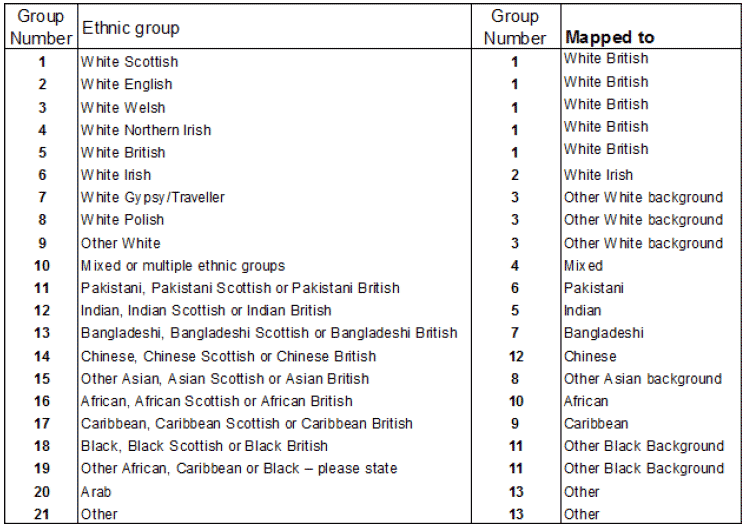Racist Incidents Recorded by the Police in Scotland, 2013-14
This bulletin presents statistics on racist incidents recorded by Police Scotland in 2013-14.
Racist incidents reported to the police may involve one or more victims/ complainers, one or more perpetrators, and may result in one or more crimes or offences being recorded.
5.2. Ethnic Classifications
While recording ethnicity for the victim/complainer and the perpetrator, an individual is asked to 'self-declare' their ethnic background. Due to differences in recording systems used, not all areas within Police Scotland (or police forces for data prior to 2013-14) were able to provide consistent data.
The racist incidents data collection uses two classifications for ethnicity: a 13- group classification and a 21-group classification. In 2013-14, Strathclyde legacy force area, was the only area to use the old 13- group classification due to constraints with their legacy system. All other forces supplied the data in the 21- group classification.
| Ethnic Classification used | |
|---|---|
| Legacy Police Force | 2013-14 |
| Central | 21-group |
| Dumfries & Galloway | 21-group |
| Fife |
21-group |
| Grampian | 21-group |
| Lothian & Borders | 21-group |
| Northern | 21-group |
| Strathclyde | 13-group |
| Tayside | 21-group |
In order to compare ethnic classifications over the time period covered by the bulletin, the new 21- group ethnicity classification has been aggregated to match the old 13- group classification. The aggregation used is detailed below:

Table 8A in this bulletin presents ethnicity data for victims/complainers using this 13- group classification. Rates for 2013-14 have also been included in Table 8A with some categories grouped together to improve accuracy. Table 8B, presents the data for the seven legacy forces who can supply the data in a 21- group classification format.
Users are advised not to use this data as a proxy for Scotland. Strathclyde legacy force area accounts for 43% (2,061) of all racist incidents in Scotland. Due to its population size, (42% of the Scottish population) and diverse ethnic breakdown of population, it is possible that inclusion of Strathclyde could alter this distribution considerably.
Over the five years from 2009-10 to 2013-14, legacy forces moved from the 13-group classification to a 21-group classification. During this transitional period, the distribution of incidents across the 13-group classification remained broadly consistent, however the distributions within the 21-group classification showed fluctuation for the individual White categories. It is likely that most of this fluctuation is due to changes in recording practice within legacy police forces and as such, data from 2012-13 and previous years, has not been included in Table 8B.
Table 12 presents data for perpetrators using a compressed 13-group classification in order to maintain disclosure principles and to provide meaningful data.
Contact
Email: Alan Sloan
There is a problem
Thanks for your feedback